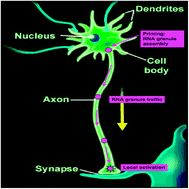Neurons are highly polarized cells with extensive sub-cellular compartmentalization to accommodate diverse local needs. Information flows between the pre-synaptic (axon) and post-synaptic (dendrite) compartments, as well as between the soma and the nerve termini. It is critical that a neuron controls efficient molecular transfer/transport through its axon. But this is extremely challenging to study because of the long distance molecules must travel through axons and the apparent contextual difference in the axons' various local environments, which should not be examined in isolation. Understanding the action in neurons of drug-responsive neurotransmitter receptors such as opioid receptors has been hindered by the lack of information on the control of molecular flow between such various sub-cellular neuron compartments. Recent studies have uncovered new transport systems other than the classical vesicle transport in neurons, particularly those utilizing various granules containing certain RNAs including protein-coding mRNAs. Through integrated approaches exploiting various experimental systems, tools, and methodologies, studies have provided solid evidence for functional roles of specific RNA granules in several biological processes crucial for the survival and function of neurons. These include neurons' transport of molecules/information, stress response, and local axonal translation. By using the kappa opioid receptor (KOR) as a model, studies have also revealed a novel physiological function of KOR in mediating growth factor-stimulated neurite outgrowth during a critical period of development, which requires specific KOR mRNA untranslated sequences that direct spatially and temporally specific expression of KOR.

You have access to this article
 Please wait while we load your content...
Something went wrong. Try again?
Please wait while we load your content...
Something went wrong. Try again?


 Please wait while we load your content...
Please wait while we load your content...